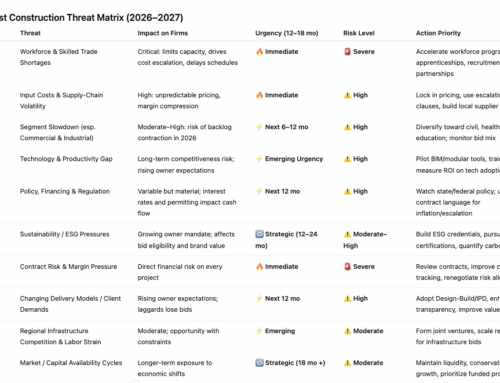By Kelly Jackson, Executive Director, SLC3
Marketing and Business Development in the Architecture, Engineering, and Construction (AEC) industry is unique due to the nature of the services provided, the long-term relationships required, and the complexity of projects. Here’s an overview of what makes business development and marketing in the AEC industry-distinct, and what tends to work and not work in the field:
- What is unique about Business Development in AEC?
- Relationship-Centric: Business development in AEC is driven heavily by relationships and trust. The industry often requires forming deep, long-term connections with clients, contractors, consultants, and stakeholders, as projects can span years. Winning business often hinges on who you know and how well you maintain and nurture these relationships over time.
- Project Complexity and Lifecycle: AEC projects are typically complex, large-scale, and involve many stakeholders. Therefore, the sales process can be slow and multifaceted, involving multiple decision-makers like architects, engineers, contractors, and owners or end users. This necessitates a highly consultative approach to business development.
- Reputation and Experience: In the AEC sector, reputation and a solid project portfolio are critical to success. Potential clients want to see evidence of successful past projects, relevant expertise, and the ability to deliver within timelines and budgets. This often means that newer firms may struggle to win contracts unless they partner with established players or have unique technical expertise. Tips on combatting the issue of never having done this type of project before will be presented soon.
- Qualifications-Based Selection (QBS): Many public sector projects in AEC are awarded based on qualifications rather than price. Business development in this setting requires firms to emphasize experience, expertise, and innovation rather than simply competing on cost. This is different from other industries where low price may be the primary decision factor.
- Networking and Industry Events: Conferences, trade shows, and professional associations are critical venues for networking. Face-to-face interactions often hold more weight than digital outreach in this industry due to the emphasis on trust and reputation. And don’t forget your support can go a long way and so does keeping yourself top of mind.
- What Works and What Doesn’t Work in Marketing for the AEC Industry?
What Works:
- Thought Leadership and Content Marketing: Many successful firms use content marketing (e.g., whitepapers, blogs, webinars) to establish themselves as experts. Thought leadership helps differentiate firms by showcasing knowledge of industry trends, regulatory changes, and innovations in design, construction techniques, or sustainability practices. Speaking is included here. Writing gets you speaking opportunities and sets you apart from others for that expertise presented.
- Client Testimonials and Case Studies: Clients in the AEC industry value past performance and real-world results, so case studies and testimonials are critical. A well-documented case study that highlights specific project challenges and the firm’s solutions can build credibility and trust with prospective clients. Try to avoid too many features without the benefits! Remember: Issue, Feature, Benefits, Proof
- Targeted Networking and Relationship Building: Marketing efforts in AEC tend to be more personalized and targeted. Rather than mass marketing, successful firms build deep relationships with a small number of decision-makers, end-users, and influencers in the industry. Don’t forget that networking can alert you to opportunities as well and keep you on top of trends and news!
- Collaboration with Partners: Many firms succeed by developing strong partnerships with other firms (e.g., architects with general contractors or engineers). Co-marketing efforts or joint proposals can help firms win projects that they wouldn’t be able to secure alone. Design Build project methodology has further proven this relationship is successful. Ensure you are present when there are opportunities to connect with partners such as networking events, training and education programs, industry-related special events, etc. Ps. The more understanding of the industry you have as a whole will only improve your ability to collaborate with others.
- Digital Presence and SEO: While relationships are key, a strong digital presence matters as well, particularly for discovery. Ensuring the firm’s website is SEO-optimized for industry-relevant keywords and regularly updated with thought leadership content can enhance visibility to potential clients. Seek opportunities digitally through organizations and online news vehicles with credibility. This will have the greatest impact for the AEC industry firm.
- Industry Credentials and Awards: Winning awards or gaining certifications (like LEED certification for sustainable buildings) can be used as marketing tools to attract clients looking for firms with recognized expertise. Do make sure this is well known by sharing it clearly when presented to decision-makers. This often gets overlooked but should be a strategic positioning move.
- Follow Instructions and Read Between the Lines: It should not have to be said to follow RFQ/RFP instructions. But per my research, at least half the companies submitting a response do not follow all instructions. This is likely due to a lack of marketing team experience, information available, support by technical staff, time, poor attention to detail, or inadequate reviews of submittal prior to submission. This is very frustrating to the Owners reviewing the submission and can be prevented. Second, understand why the questions asked are being asked. Discuss it with your strategic team and prepare a response to who you believe the selection panel really wants to know and what is most important to them. In other words, doing your research on the selection team and needs for the project will pay off.
- Best Practices: Following best practices is a fantastic way to differentiate. What are the best practices and what makes them a best practice? Decision makers may be fixated on dollars and time, but, best practices help make the projects smoother, thus reducing stress and worry. It can check many boxes and set you apart.
What Doesn’t Work:
- Over-reliance on Cold Outreach: Cold calls or generic email blasts tend to be less effective in AEC marketing. Decision-makers in this industry prefer to work with firms they know or have a strong reputation, and unsolicited outreach often feels impersonal and irrelevant.
- Competing on Price Alone: While cost is a factor, especially in competitive bidding, firms that position themselves as the “cheapest” solution often find themselves overlooked for projects where quality, innovation, and trust are prioritized. Low-balling bids may also result in profit margins being squeezed too tightly to sustain business.
- Broad, Non-Specific Messaging: Vague or overly general marketing messages don’t resonate in the AEC world, where clients look for niche expertise and a specific track record. Generic claims like “the best architects” or “high-quality construction services” without proof points won’t distinguish a firm from the competition. Again, if your differentiators are not benefits, they are feature statements just like everyone else. And avoid gimmicks. They don’t belong here.
- Traditional Advertising: While digital marketing has a place, traditional mass advertising (e.g., billboards, TV ads) often doesn’t yield strong results. AEC clients are typically not influenced by broad advertising, as they tend to rely on referrals, past experience, industry networks, and reputation. Note sponsorships are NOT advertising. If there is no call to action, then it is sponsorship. This includes phone numbers, websites, etc.
- How is Marketing Professional Services Different?
Marketing professional services in the AEC industry differ significantly from marketing products or other types of services. Key distinctions include:
- Intangible Services: Professional services in AEC are largely intangible, making it harder to showcase what’s being “sold” compared to physical products. The focus is on expertise, problem-solving ability, and trust. As a result, marketing efforts emphasize the people behind the services and the knowledge they bring to the table.
- Project-Based and High Stakes: Projects in AEC are typically high-cost, high-stakes, and long-term, so clients take more time in decision-making. Firms must prove not just competency but also reliability, foresight, and an ability to mitigate risk over long timelines. Overlooking questions on safety practices or programs isn’t wise for example.
- Emphasis on Personal Relationships: In product-based industries, marketing may focus more on product benefits and features, but in AEC, marketing professional services is often more about building personal relationships with decision-makers, gaining their trust, and maintaining communication throughout long project cycles. This makes who’s on your team that much more competitive. Skills in communication may prove even more important and stand out as the generations shift.
- Customization and Differentiation: AEC marketing must often demonstrate how a firm can tailor its services to meet specific project needs. Clients expect a degree of customization, which means generic marketing materials won’t suffice. Branding and positioning planning and strategy are often overlooked and undervalued. How can you really know what is different about you if you don’t know enough about your competition? And have you asked your clients why they selected you and/or continue to work with you? Be sure to be true to what you do deliver as falsely portraying who you are can have detrimental effects on your reputation.
- Can You Really Be Different in Such an Industry?
Yes, differentiation is possible in the AEC industry, though it can be challenging because of the homogeneity of services offered by many firms. Successful differentiation strategies include:
- Niche Expertise: Specializing in a particular market segment (e.g., healthcare facilities, sustainable design, or historic preservation) can set a firm apart. Clients in these niches are often willing to pay a premium for firms with highly specific expertise.
- Innovative Technology: Firms that invest in cutting-edge technology (e.g., Building Information Modeling (BIM), AI for project management, or sustainable construction techniques) can differentiate themselves by offering clients efficiency, cost savings, or higher-quality deliverables.
- Client Experience: Differentiating on client experience—such as offering superior communication, project transparency, and post-project support—can help set a firm apart, even if the technical services are similar to competitors.
- Sustainability and Social Responsibility: As more clients prioritize sustainability, firms that are leaders in green building practices or who adopt a strong social responsibility narrative (e.g., working with local communities, adopting ethical labor practices) can stand out.
- Branding and Storytelling: Firms that invest in a strong brand narrative, aligning their mission and values with the goals of their clients, can differentiate themselves in an industry where branding is often an afterthought.
- Culture: For all leaders of organizations, the culture and your company values do play an enormous role in the success of your sales and marketing efforts. Nothing can be more deflating to the sales and marketing team than sour apples in your basket. And, no one enjoys working with team members who are impacted negatively by the culture where they reside. A bad culture permeates into everything.
In conclusion, AEC business development and marketing is unique due to its relationship-driven nature, project complexity, and reliance on expertise and reputation. Firms that succeed in differentiating themselves often do so through niche expertise, innovation, best practices and strong relationship-building rather than broad or traditional marketing techniques.






